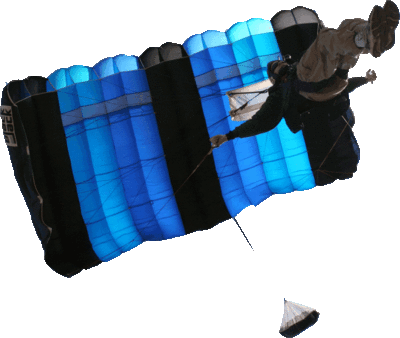Recommended Posts
The pattern of behavior that results in a jumper rushing a pack job has little or nothing to do with what he or she is jumping and, that jumper is likely to have problems regardless of what type of gear he or she starts jumping first.
As you mentioned jumpers don't typically slow their pack jobs down as they get more experienced. In fact, they speed up.
So then wouldn't you agree that perhaps the time to teach them good habits is when they still have a great deal of fear, they are moving slowly. and you are there to help? What they do with the knowledge later is their business god bless em.
IMO Velcro should not be used as "training wheels" for pin rigs.
Take some one who has 50 jumps on a velcro rig and then give him a pin rig. Left to their own devices, they will no doubt, attempt to apply what they know about packing a velcro rig to packing the pin rig. Feeling some what invincible do to their "vast" amount of jumps, they may not ask for help cause think they can handle it, and Viola! they fuck it up. I know the majority of us are smart enough to ask questions but there are plenty out there who don't. They are (not always) usually the ones we read about.
I say, train like you play on the gear you will be using. We don't train computer geeks on the old 486 coumputers do we? Then why train on velcro if that is not what you will be jumping in the future?
As you mentioned jumpers don't typically slow their pack jobs down as they get more experienced. In fact, they speed up.
So then wouldn't you agree that perhaps the time to teach them good habits is when they still have a great deal of fear, they are moving slowly. and you are there to help? What they do with the knowledge later is their business god bless em.
IMO Velcro should not be used as "training wheels" for pin rigs.
Take some one who has 50 jumps on a velcro rig and then give him a pin rig. Left to their own devices, they will no doubt, attempt to apply what they know about packing a velcro rig to packing the pin rig. Feeling some what invincible do to their "vast" amount of jumps, they may not ask for help cause think they can handle it, and Viola! they fuck it up. I know the majority of us are smart enough to ask questions but there are plenty out there who don't. They are (not always) usually the ones we read about.
I say, train like you play on the gear you will be using. We don't train computer geeks on the old 486 coumputers do we? Then why train on velcro if that is not what you will be jumping in the future?
Lonnie 0
WELL PUT KEVIN!! I AGREE TOTALLY!
It goes back to KISS.
It goes back to KISS.
NEVER GIVE UP!
K763 0
HEY LONNIE!!!!
Good to see you online. I'm glad you're keeping an eye on us morons.
I'll be the first to say that I don't know sh*t, but I agree with Kevin and Lonnie. I never have liked Velcro rigs, I've only jumped on once, and ABSOLUTELY HATE to pack them.
I started with a Prism (BR single pin rig) and I still love it to this day. I also now have a 2 pin rig, the Vertex 2 with the cornerless bottom design, and even tho the 2 pins are easier to close, the dynamic corner rig is pretty tricky to work.
Velcro rigs require quite a bit more maintenance than a pin rig, they aren't as secure for aerials, terminal jumps, and climbing antenna ladders, and THEY OPEN SLOWER THAN ANY PIN RIG. Thanks to Kevin for proving that unequivocably at TF one summer.
Besides, do you want to buy something you're going to want to replace so soon? Especially when it's getting harder and harder to sell Velcro to any one. We've had many Reactor 4's on sale for quite some time, and no one is buying. Maybe you should just plan to keep it for a secondary rig, and use it for the wet stuff or the high bust factor jumps. I'd rather see a Velcro rig get confiscated than any of my pinned babies!!!
So I was going to keep my 2 cents to myself, but when I saw Lonnie on here I just couldn't stop myself.
xo
K

Good to see you online. I'm glad you're keeping an eye on us morons.
I'll be the first to say that I don't know sh*t, but I agree with Kevin and Lonnie. I never have liked Velcro rigs, I've only jumped on once, and ABSOLUTELY HATE to pack them.
I started with a Prism (BR single pin rig) and I still love it to this day. I also now have a 2 pin rig, the Vertex 2 with the cornerless bottom design, and even tho the 2 pins are easier to close, the dynamic corner rig is pretty tricky to work.
Velcro rigs require quite a bit more maintenance than a pin rig, they aren't as secure for aerials, terminal jumps, and climbing antenna ladders, and THEY OPEN SLOWER THAN ANY PIN RIG. Thanks to Kevin for proving that unequivocably at TF one summer.
Besides, do you want to buy something you're going to want to replace so soon? Especially when it's getting harder and harder to sell Velcro to any one. We've had many Reactor 4's on sale for quite some time, and no one is buying. Maybe you should just plan to keep it for a secondary rig, and use it for the wet stuff or the high bust factor jumps. I'd rather see a Velcro rig get confiscated than any of my pinned babies!!!
So I was going to keep my 2 cents to myself, but when I saw Lonnie on here I just couldn't stop myself.
xo
K
base311 0
QuoteWe've had many Reactor 4's on sale for quite some time, and no one is buying.
Whatchya askin' for 'em?
Gardner
Less fabric makes it a little easier to get the sides arround the pack job without moving anything - so I like to make my first S-fold, close the sides (velcro) or top and top sides (pin), make the last fold, insert the remaining fabric from the bottom, and then close the bottom.
On my velcro rig I have to be careful to avoid peeling the shrivel flap. On my pin rig everything stays parked.
Apart from that minor difference closing difficulty is the same.
Sub-optimal shape of the pack-job and/or top fold placement on my velcro rig means that by rolling my shoulders in I can get velcro peeling noises and a slight spread of the velcro at the top. My pin rig doesn't suffer from that and it takes greater variation in pack jobs to change the top pin tension. This was more of an issue when I started packing.
I wouldn't buy a new velcro rig but don't regret buying a used one as an inexpensive first rig and won't go through the trouble of replacing it with another pin rig.
On my velcro rig I have to be careful to avoid peeling the shrivel flap. On my pin rig everything stays parked.
Apart from that minor difference closing difficulty is the same.
Sub-optimal shape of the pack-job and/or top fold placement on my velcro rig means that by rolling my shoulders in I can get velcro peeling noises and a slight spread of the velcro at the top. My pin rig doesn't suffer from that and it takes greater variation in pack jobs to change the top pin tension. This was more of an issue when I started packing.
I wouldn't buy a new velcro rig but don't regret buying a used one as an inexpensive first rig and won't go through the trouble of replacing it with another pin rig.
BASE813 0
Quoteso I like to make my first S-fold, close the sides (velcro) or top and top sides (pin), make the last fold, insert the remaining fabric from the bottom, and then close the bottom.
just curious, but is anyone using the one fold and then roll method that i use? (i make the first fold then roll up the "ears"individually into the bottom of the container after making certain dressing)
I have found advantages in using this method, and wondered if anyone else is doing something similar...........again, just curious...................
leroydb 0
I think I am using that method. I set the tail pocket in, make the first fold and secure the top closing loop first.
I like this method because it secures the nose fold and I can get up and then dress the other folds up...
I like this method because it secures the nose fold and I can get up and then dress the other folds up...
Leroy
..I knew I was an unwanted baby when I saw my bath toys were a toaster and a radio...
..I knew I was an unwanted baby when I saw my bath toys were a toaster and a radio...
TomAiello 25
Quotejust curious, but is anyone using the one fold and then roll method that i use? (i make the first fold then roll up the "ears"individually into the bottom of the container after making certain dressing)
I use that sometimes.
Dennis McGlynn taught that method to a lot of people over the years, so I'm sure there are plenty of folks doing it.
Isn't this "roll the ears" technique how riggers do reserves in skydiving rigs? Getting it into the molar bag nicely that is.
TomAiello 25
QuoteI have found advantages in using this method, and wondered if anyone else is doing something similar...........again, just curious...................
Can you elaborate on what advantages? I primarily like the fact that it fills the bottom corners better on some rigs, and that it gets the "ears" out of the way of the bridle.
I think Leroy's got a good point that if you close the top flap first, it could also help keep the nose in position.
I have always avoided rolling anything in my pack job except of course for terminal jumps. I have always felt that if I roll some thing up while packing, then it would have to unroll during unpacking and do so at high speed. This is bad for two reasons.
First, there is a higher potential for an asymmetric opening caused by one side unrolling faster than the other. In my opinion This is a very frequent cause of off heading openings experienced by most jumpers.
Second, In addition to asymetrical openings, there is a higher chance of burning the canopy material as it whips past it self while unrolling. This of course is not only costly to repair, but it can turn serious real fast.
My earliest experience with sewing machines was gained by repairing damage caused by burns to my canopy. Back in the day, I did those repairs alot.
Not so much any more.
Personally I have always found it easier to pin the bottom pin first the shake the canopy down into the corners at the bottom of the rig. Admittedly, I have not jumped any other make of pin rig besides my own so I can't offer an opinion about how others should be packed but to me top pin just seemed logical.
First, there is a higher potential for an asymmetric opening caused by one side unrolling faster than the other. In my opinion This is a very frequent cause of off heading openings experienced by most jumpers.
Second, In addition to asymetrical openings, there is a higher chance of burning the canopy material as it whips past it self while unrolling. This of course is not only costly to repair, but it can turn serious real fast.
My earliest experience with sewing machines was gained by repairing damage caused by burns to my canopy. Back in the day, I did those repairs alot.
Not so much any more.
Personally I have always found it easier to pin the bottom pin first the shake the canopy down into the corners at the bottom of the rig. Admittedly, I have not jumped any other make of pin rig besides my own so I can't offer an opinion about how others should be packed but to me top pin just seemed logical.
[ but to me top pin just seemed logical.
Oops meant bottom pin sorry
BASE813 0
I found that it fills out the container more consistantly so pin pressure is more consistant. It helps fill out the corners with dynamic corners. I have had an increase in heading performance since using this method (although I do think packing is a small effect on overall heading performance). I have found it generally much easier to pack and close with both velcro and pins.
TomAiello 25
Have you experienced any fabric burning of the type Kevin describes?
Kevin, do you think that folding the "ears" (rather than rolling) would reduce this problem?
Kevin, do you think that folding the "ears" (rather than rolling) would reduce this problem?
I think that it really depends on how much they are folded. How much is too much some may ask? I only fold the canopy (or any part of it) enough so that I can place it cleanly into the container and no more. I know thats not as scientific as some would like but everyone will need to figure it out for them selves. Most already have.
Where the canopy folds are made and how each canopy fits into a container is specific to the combination of rig and canopy.
I should say though that folding can and some times does cause the same damage as rolling so don't get too carried away
Where the canopy folds are made and how each canopy fits into a container is specific to the combination of rig and canopy.
I should say though that folding can and some times does cause the same damage as rolling so don't get too carried away
hookitt 0
Where were you finding the canopy damage?
My grammar sometimes resembles that of magnetic refrigerator poetry... Ghetto



Sure. But I haven't found a good way to address this one yet. The problem is not generally with the pack jobs they do when I'm standing there. It's with the pack jobs after they leave. Of the folks I've seen having this problem, none had it when they were receiving instruction (or at least, if they did, they were able to correct it when it was explained). It was almost always something that developed after instruction, or something they developed on their own while self-instructing.
Note that I've seen people who took courses from other people (not me), and used pin rigs in their courses (and presumably didn't have this issue during the course), who I later encountered, and observed to be doing this. Generally, it was something they started doing on their own, when they were gaining confidence in their pack job on later jumps, and hence going a bit faster.
[email protected]
SnakeRiverBASE.com
Share this post
Link to post
Share on other sites